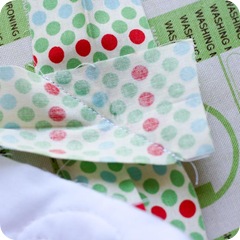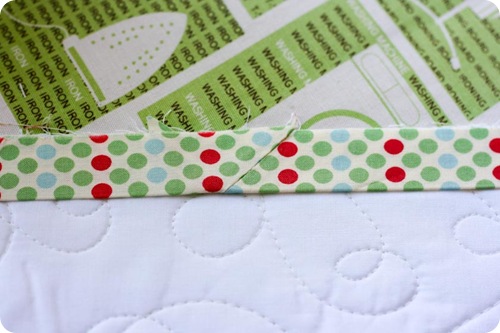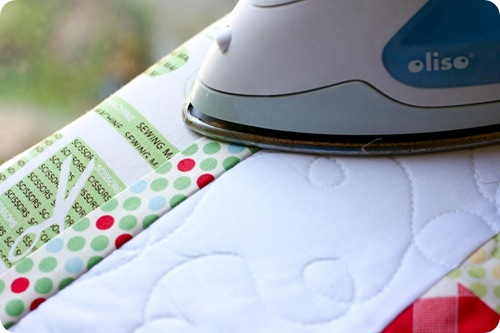Binding Tutorial Part 2
There are gobs and gobs of good tutorials out there on attaching your binding, but I wanted a simpler more condensed version of what I have in the sidebar already. You can find Part 1 here.
Directions
1. Pick a side of your quilt, somewhere around the middle and position your binding, leaving your self a generous tail (unsewn) of your binding for later attaching to your other end.
Now, there is two ways I do this next part, the first is the lazy way:
 |
 |
2. Stitch down the length of your binding until your a few inches from the end. Stop sewing and fold the end of your binding at a right angle with the diagonal of that fold lining up with the corner of your quilt. Finger press.
3. Open out and continue sewing until your needle reaches that crease. Backstitch a few times to hold in place. Clip your thread and remove from the machine.
If you’re so inclined, once you reach the crease on your binding, you can pivot your quilt 90 degrees, shorten your stitch length and sew to the edge of the quilt. But this step is not required or really crucial (as far as I can tell).
 |
 |
4. Flip your binding up at a 90 degree angle (same as step 3) and place a pin to help hold in place. Then flip the fabric straight down and pin. I just reuse the pin that helped hold the angle in place.
5. Starting from folded edge, begin sewing (backstitching a few times) and continue until you reach the end, repeating steps 2 and 3.
. . . . . . . . . . . . . . . . . . . . . . . . . . . . . . . . . . . . . . . . . . . . . . . . . . . . . . . .
So the second way I go about doing this, the less-frustrating-when-sewing method is to use Elmer’s Glue and and an iron to keep my binding in place. The steps above are all the same, I just add a thin bead of Elmer’s Glue (or any water based, washable glue) to the binding where I’ll be sewing (one side at a time) and then I iron it to heat set the binding in place. Then I sew as usual. This is SO much less frustrating because the binding doesn’t bunch or run away from me. It stays in place, no pins required. It takes a little more work up front, but I think it makes up for it along the way, and really it takes the same amount of time as the “lazy” way, as I like to call it.
 |
 |
 |
 |
A. Add a bead of glue down the side of the quilt where you will be attaching the binding first (keeping it within your seam allowance), keep the glue about an 1/8” away from the corner.
B. Lay your binding down on the glue, matching the raw edge of the binding with the raw edge of the quilt, and PRESS (the motion of lifting and setting the iron down, not moving back and forth as this will stretch the fabric) the binding in place, resting a few seconds at each spot to make sure the glue dries and adheres the binding to the quilt.
C. At the corner of the quilt, flip the binding up at 90 degrees, creating that right angle as in step 2 above, and press with an iron.
D. Now stitch down the length of your binding and continue with step 4 above and then repeat these steps for the other sides of your quilt.
Since this is a washable glue, when you toss the quilt in the wash the glue will be washed away. That’s why it’s important to use a washable glue, and not a permanent fabric glue.
. . . . . . . . . . . . . . . . . . . . . . . . . . . . . . . . . . . . . . . . . . . . . . . . . . . . . . . .
Joining Your Binding
**I now join the ends of my binding by a different method. I use the Binding Tool by Fons & Porter and walk you through the steps of that in this post.**
Once you’ve sewn the binding down to the three sides and you’re back to your last side, make sure and leave about a 10” gap from the start of your binding to the end of your binding, make sure you have a long tail of binding unattached at the end.
 |
 |
 |
 |
1. On the beginning tail of your binding, fold it back on itself an inch or so from the end and press. (Make sure you have enough from this fold and the other end of your binding to cover your space that still needs binding.)
2. Clip it off about a 1/2” from the crease.
3. Open out your binding and line up the crease you just pressed with the top, raw edge of your binding. This creates a right angle as shown. Press this fold.
4. Fold your binding back in half, leaving the right angle fold in place.
 |
 |
 |
 |
5. Nestle the end side of your binding into your start side of binding, clip excess binding so that about 2” of binding is nested inside the other.
6. Add a little glue to the angle fold of your starting side of binding and press to your ending side of binding that is nested. Repeat this for the backside of binding, continuing along that angled fold. Press to heat set.
**Sometimes I just lay a bead of blue along the whole of the angle fold and then gingerly set my other piece of binding onto it. Since the glue isn’t permanent, its not a big deal if a little bit gets out of place.
7. Open out your binding and turn it until you have the angle fold facing you, as shown in photo.
8. Now scrunch your quilt together a bit and sew along that angle. This creates an angle just like your binding when originally assembled. Clip away excess fabric, leaving a 1/4” seam allowance.
**Note that you may need to reverse the directions I’ve given here to match up with your binding angles. (Which I don’t think I did here…oh well, at least it was still an angle!) You will just do these directions on the ending side of the binding instead of the starting side.
9. Fold your binding back together and press. Stitch down this open length of binding, backstitching at start and finish.
10. Finally, after sewing, I press the binding up and away from the quilt top to prepare of stitching to the back.
And in the next (and final) installment of the binding tutorial, I will show you how I stitch it down to the back. Time for me to get the macro lens on my camera…







